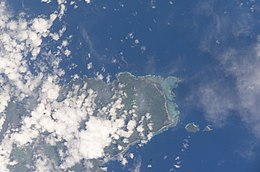 Satellite image of the Aleipata Islands Satellite image of the Aleipata Islands | |
| Geography | |
|---|---|
| Area | .23 km (0.089 sq mi) |
| Coastline | 2.80 km (1.74 mi) |
Nuʻulua is an island in Samoa (not to be confused with the landmass also called Nuʻulua that lies 200 meters west of Ofu in American Samoa). It is located in the Aleipata Islands, somewhat more than 1.3 km from the eastern end of Upolu (a much larger island that is also part of Samoa).
Nuʻulua has a land area of 25 hectares. It is a habitat for locally and regionally endemic birds, including the endangered tooth-billed pigeon (Didunculus strigirostris), also known as the Samoan pigeon, and also for an endemic bat (Pteropus samoensis).
Nuʻulua and Nu'utele, another island in the Aleipata Islands grouping, are together home to the largest seabird colonies in Samoa, and have been identified as highly significant sites for conservation efforts. One of the efforts is to eradicate these islands’ populations of Pacific rats (Rattus exulans) that prey on their native insects, birds and lizards.
These islands are remnants of eroded volcanic tuff rings.
In keeping with local custom, both islands are owned ex officio by the holders of certain chiefly titles in the villages of Aleipata on Upolu Island.
See also
References
- Global Endemic Species Database. Retrieved 25 October 2009
- Cooperative Islands Initiative. Retrieved 25 October 2009
- Restoration of Nu'utele and Nu'ulua Islands, Samoa by David J. Butler, April 2005, SPREP. Retrieved 25 October 2009
| Traditional center: Lufilufi | ||
| Villages |  | |
| Landmarks | ||
| Islands |
| |
| Environment | ||
| Electoral constituencies: Faipule Districts |
| |
| Islands of Samoa (Independent State of Samoa) | |
|---|---|
| Principal islands | |
| Small inhabited islands | |
| Uninhabited islands | |
14°04′22″S 171°24′38″W / 14.0728°S 171.4106°W / -14.0728; -171.4106
This article about a geographical location in Samoa is a stub. You can help Misplaced Pages by expanding it. |